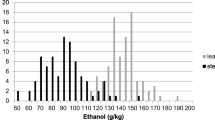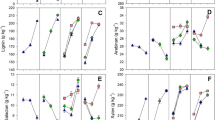Abstract
Quantifying actual and theoretical ethanol yields from biomass conversion processes such as simultanteous saccharification and fermentation (SSF) requires expensive, complex fermentation assays, and extensive compositional analyses of the biomass sample. Near-infrared reflectance spectroscopy (NIRS) is a non-destructive technology that can be used to obtain rapid, low-cost, high-throughput, and accurate estimates of agricultural product composition. In this study, broad-based NIRS calibrations were developed for switchgrass biomass that can be used to estimate over 20 components including cell wall and soluble sugars and also ethanol production and pentose sugars released as measured using a laboratory SSF procedure. With this information, an additional 13 complex feedstock traits can be determined including theoretical and actual ethanol yields from hexose fermentation. The NIRS calibrations were used to estimate feedstock composition and conversion information for biomass samples from a multi-year switchgrass (Panicum virgatum L.) biomass cultivar evaluation trial. There were significant differences among switchgrass strains for all biomass conversion and composition traits including actual ethanol yields, ETOHL (L Mg−1) and theoretical ethanol yields, ETOHTL (L Mg−1), based on cell wall and non-cell wall composition NIRS analyses. ETOHL means ranged from 98 to 115 L Mg−1 while ETOHTL means ranged from 203 to 222 L Mg−1. Because of differences in both biomass yields and conversion efficiency, there were significant differences among strains for both actual (2,534–3,720 L ha−1) and theoretical (4,878–7,888 L ha−1) ethanol production per hectare. It should be feasible to improve ethanol yields per hectare by improving both biomass yield and conversion efficiency by using NIRS analyses to quantify differences among cultivars and management practices.
Similar content being viewed by others
References
Vogel KP, Jung HG (2001) Genetic modification of herbaceous plants for feed and fuel. Crit Rev Plant Sci 20:15–49
Roberts CA, Workman, J Jr, Reeves JB III (eds.) (2004) Near-infrared spectroscopy in agriculture. Agron Monog 44. ASA, CSSA, and SSSA, Madison, WI.
Westerhaus M, Workman J, Reeves JB III, Mark H (2004). Quantitative analysis. In: Roberts CA, Workman J. Jr., Reeves JB (eds) Near-infrared spectroscopy in agriculture. Agron. Monog. 44. ASA, CSSA, and SSSA, Madison, WI, p 133–174
Shenk JS, Westerhaus MO (1991) Population definition, sample selection, and calibration procedures for near-infrared reflectance spectroscopy. Crop Sci 31:469–474
Wold S, Geladi P, Esbensen K, Öhman J (1987) Multi-way principal components and PLS analysis. J Chemom 1:41–56
Wold S, Kettanehwold N, Skagerberg B (1989) Nonlinear PLS modeling. Chemom Intell Lab Syst 7:53–65
Himmel ME (2007) Biomass recalcitrance: engineering plants and enzymes for biofuels production. Science 306:982
Yanase H, Yamamoto K, Matsuda S, Yamamoto S, Okamoto K (2007) Genetic engineering of Zymobacter palmae for production of ethanol from xylose. Appl Environ Microbiol 73:2592–2599
Sanderson MA, Agblevor F, Collins M, Johnson DK (1966) Compositional analysis of biomass feedstocks by near infrared reflectance spectroscopy. Biomass and Bioenergy 111:365–370
Maranan MC, Laborie MPG (2007) Analysis of energy traits of Populus spp. clones by near-infrared spectroscopy. J Biobased Mater Bioenergy 1:155–165
Hames BR, Thomas SR, Sluiter AD, Roth CJ, Templeton DW (2003) Rapid biomass analysis—new tools for compositional analysis of corn stover feedstocks and process intermediates from ethanol production. Appl Biochem Biotechnol 105:5–16
Lamb JFS, Jung HG, Sheaffer CC, Samac DA (2007) Alfalfa leaf protein and stem cell wall polysaccharide yields under hay and biomass management systems. Crop Sci 47:1407–1415
Lorenz AJ, Coors JG, de Loen N, Wolfurm EJ, Hames BR, Sluiter AD, Weimer PJ (2009) Characterization, genetic variation, and combining ability of maize traits relevant to the production of cellulosic ethanol. Crop Sci 59:85–98
Lorenzana RE, Lewis MF, Jung HG, Bernardo R (2010) Quantitative trait loci and trait correlations for maize stover cell wall composition and glucose release for cellulosic ethanol. Crop Sci 50:541–555
Vogel KP, Brejda JJ, Walters DT, Buxton DR (2002) Switchgrass biomass production in the Midwest USA: harvest and nitrogen management. Agron J 94:413–420
Casler MD, Vogel KP, Taliaferro CM, Wynia RE (2004) Latitudinal adaptation of switchgrass populations. Crop Sci 44:293–403
Moore KJ, Moser LE, Vogel KP, Waller SS, Johnson BE, Pedersen JF (1991) Describing and quantifying growth stages of perennial forage grasses. Agron J 83:1073–1077
Varvel GE, Vogel KP, Mitchell RB, Follett RF, Kimble JM (2008) Comparison of corn and switchgrass on marginal soils for bioenergy. Biomass and Bioenergy 32:18–21
Vogel KP, Mitchell RB (2008) Heterosis in switchgrass: biomass yield in swards. Crop Sci 48:2159–2164
Murray I, Cowe, I (2004) Sample preparation. In: Roberts CA, Workman J Jr, Reeves JB III (eds) Near-infrared spectroscopy in agriculture. Agron Monog 44. ASA, CSSA, and SSSA, Madison, WI, p 75–112
Dien BS (2010) Mass balances and analytical methods for biomass pre-treatment experiments. In: Vertes A, Qureshi N, Yukawa H, Blaschek H (eds) Biomass to biofuels: strategies for global industries. Wiley, United Kingdom, pp 213–231
Bremner JM (1996) Nitrogen - Total. p. 1085–1121. In Sparks DL et al. (ed.) Methods of soil analysis. Part 3. Chemical methods. SSSA Book Ser. 5. SSSA and ASA, Madison, WI.
Watson M E, Issac RA (1990) Analytical instruments for soil and plant analysis. In Westerman R (ed) Soil testing and plant analysis. (3rd Ed.). SSSA Book Ser. 3. SSSA, Madison, WI, p 691–704
Padmore JM (1990a) Fat (crude) or ether extract in animal feed. Method 920.39. In: Herlich K (ed). Official methods of analysis of Association of Official Analytical Chemists. 15th ed. Arlington, VA.
Dien BS, Jung HG, Vogel KP, Casler MD, Lamb JFS, Weimer PJ, Iten L, Mitchell RB, Sarath G (2006) Chemical composition and response to dilute-acid pretreatment and enzymatic saccharification of alfalfa, reed canarygrass, and switchgrass. Biomass Bioenergy 30:880–891
Smith D (1973) The nonstructural carbohydrates. In: Butler GW, Bailey RW (eds) Chemistry and biochemistry of herbage, vol 1. Academic, New York, pp 105–155
Theander O, Aman P, Westerlund E, Andersson R, Pettersson D (1995) Total dietary fiber determined as neutral sugar residues, uronic acid residues, and Klason lignin (the Uppsala method): collaborative study. J AOAC Int 78:1030–1044
Ahmed AER, Labavitch JM (1977) A simplified method for accurate determination of cell wall uronide content. J Food Biochem 1:361–365
Iiyama K, Lam TBT, Stone BA (1990) Phenolic acid bridges between olysaccharides and lignin in wheat internodes. Phytochemistry 29:733–737
Jung HG, Shalita-Jones SC (1990) Variation in the extractability of esterified p-coumaric and ferulic acids from forage cell walls. J Agric Food Chem 38:397–402
Dowe N, McMillan J (2001) SSF Experimental Protocols—Lignocellulosic Biomass Hydrolysis and Fermentation; Laboratory Analytical Procedure (LAP). National Renewable Energy Laboratory, NREL/TP-510-42630. Available at http://www.nrel.gov/biomass/pdfs/42630.pdf. Accessed 08 Jan 09.
Dien BS, Nagle N, Hicks KB, Singh V, Moreau RA, Tucker MP et al (2004) Fermentation of "Quick Fiber" produced from a modified corn-milling process into ethanol and recovery of corn fiber. Appl Biochem Biotechnol 113–116:937–949
Padmore JM (1990b) Protein (crude) in animal feed Dumas method. Method 968.06. In: Herlich K (eds) Official methods of analysis of Association of Official Analytical Chemists. 15th ed. Arlington, VA
Vogel KP, Pedersen JF, Masterson SD, Toy JJ (1999) Evaluation of a filter bag system for NDF, ADF, and IVDMD forage analysis. Crop Sci 39:276–279
SAS (2000-2004) SAS 9.1.3 help and documentation. SAS Institute Inc, Cary
Williams PC (1987) Variables affecting near-infrared reflectance spectroscopic analysis. In: Williams P, Norris K (eds) Near-infrared technology in the agriculture and food industries. 1st Ed. Am Cereal Assoc Cereal Chem, St. Paul, MN. p 143–167
Author information
Authors and Affiliations
Corresponding author
Additional information
For abbreviations used in this paper, please refer to Table 1.
USDA neither guarantees nor warrants the standard of the product, and the use of the name by USDA implies no approval of the product to the exclusion of others that may also be suitable.
Ms. Patricia O’Bryan and Mr. Ted Joe are acknowledged for their excellent technical support in conducting the laboratory fermentation and composition experiments.
Rights and permissions
About this article
Cite this article
Vogel, K.P., Dien, B.S., Jung, H.G. et al. Quantifying Actual and Theoretical Ethanol Yields for Switchgrass Strains Using NIRS Analyses. Bioenerg. Res. 4, 96–110 (2011). https://doi.org/10.1007/s12155-010-9104-4
Published:
Issue Date:
DOI: https://doi.org/10.1007/s12155-010-9104-4




